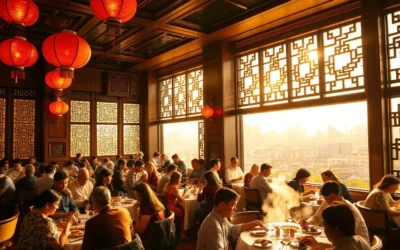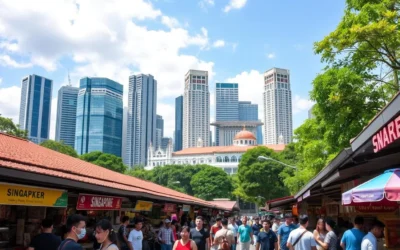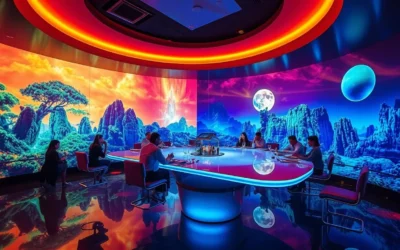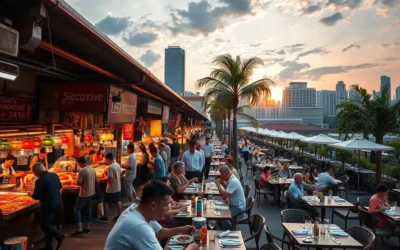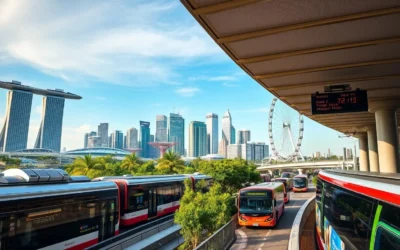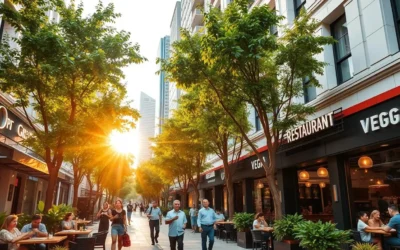✓ Accommodations ✓ Flights ✓ Rental Cars ✓ Tours & Activities
Imagine a city where modern skyscrapers seamlessly blend with lush green spaces, creating a unique harmony of urban and natural beauty. Welcome to Singapore, a global hub in Southeast Asia that is renowned for its impressive skyline and architectural marvels. As you explore this vibrant place, you’ll discover a diverse array of experiences that cater to all types of travelers, from food enthusiasts to nature lovers.
This “City in a Garden” offers a multitude of attractions and activities to enjoy during your time here. With its efficient public transportation and cleanliness, navigating Singapore is a breeze. Our guide will help you uncover both iconic landmarks and hidden gems, ensuring that your visit is nothing short of extraordinary. As one of the world’s safest and most livable city in the world, Singapore promises an unforgettable experience.
Discovering Singapore’s Unique Charm
As you step into Singapore, you’re immediately immersed in a vibrant tapestry of cultures that define this city. The blend of Chinese, Malay, Indian, and Western influences creates a unique urban experience that is both captivating and enriching.
Singapore is an incredibly diverse country with many subcultures to explore. The people of Singapore take pride in their multicultural heritage, which is reflected in the various places you visit. From ultramodern skyscrapers to colonial-era buildings and traditional shophouses, the architecture is a testament to the area‘s rich history.
A City of Contrasts and Diversity
The multicultural neighborhoods in Singapore are a highlight, showcasing the heritage and communities that make this city-state so unique. You can explore the different areas, each with its own distinct character, and experience the diversity that Singapore has to offer.
- Experience the blend of cultures in Singapore’s vibrant neighborhoods.
- Discover the balance between modern and traditional architecture.
- Explore the multicultural heritage and communities.
Singapore has transformed from a small fishing village to one of Asia’s most important economic centers. The city’s compact size makes it easy to explore multiple distinct areas in a single day, taking in the diverse languages, religions, architecture, and cuisine that reflect the country‘s rich cultural tapestry.
| Aspect | Description | Highlights |
|---|---|---|
| Cultural Diversity | Blend of Chinese, Malay, Indian, and Western influences | Hawker centers, cultural festivals |
| Architecture | Mix of ultramodern and traditional buildings | Marina Bay Sands, historic shophouses |
| Cuisine | Diverse food scene reflecting multicultural heritage | Chili crab, Hainanese chicken rice |
Getting Around Singapore

Navigating Singapore is a breeze, thanks to its comprehensive public transportation system. The Mass Rapid Transit (MRT) network is the backbone of this system, connecting most major attractions and places of interest.
The MRT is efficient, reliable, and easy to use. You can travel conveniently across the city using your EZ-Link card, which is not only affordable but also widely accepted at MRT stations, buses, and even some parking facilities. This card eliminates the need to buy separate tickets for different modes of transport, making your travel experience smooth and hassle-free.
Besides the MRT, Singapore is also very walkable, with many pedestrian-friendly areas and connecting trails. You can explore the city’s main districts on foot, enjoying the sights and sounds along the way. For longer distances or when you’re short on time, ride-sharing services and taxis are readily available.
Visitors can also opt for the Singapore Tourist Pass, which offers unlimited rides on public transport for a fixed period. This is a great option if you plan to use public transport frequently during your stay.
To make the most of your time in Singapore, consider avoiding rush hours (usually during morning and evening commutes) when the MRT is busiest. With Singapore’s compact size, you can visit multiple attractions in a single day, making the most of your trip.
Marvel at Changi Airport’s Jewel Rain Vortex
The Jewel complex at Changi Airport boasts an engineering wonder that will leave you speechless: the Rain Vortex. As the world’s tallest indoor waterfall, standing at an impressive 40 meters (130 ft) high, it’s a must-see attraction even for travelers just transiting through Singapore.
A Masterpiece of Engineering
The Rain Vortex is not just a visual spectacle; it’s also an exemplary model of environmentally conscious design. The waterfall recirculates rainwater, pumping it up to the roof to free fall through a round hole, creating a beautiful vortex. This innovative system showcases Singapore’s commitment to sustainability and innovative engineering.
When visiting the Rain Vortex, make sure to catch it during the evening light shows, which add an extra layer of magic to this already mesmerizing display. The best viewing spots are from the lower levels, where you can appreciate the sheer scale and beauty of the waterfall.
Exploring Beyond the Rain Vortex
Surrounding the Rain Vortex is the serene Shiseido Forest Valley, featuring lush, terraced gardens that complement the waterfall’s natural beauty. This area provides a tranquil escape from the bustling airport and shopping mall. Jewel is more than just a visual attraction; it’s a shopping and dining paradise. With a wide range of local and international brands, you’ll find something to suit every taste and budget.
Accessing Jewel from different airport terminals is straightforward. You can connect to Jewel via walkways from Terminals 1, 2, and 3, or take the MRT directly to Jewel Changi Airport station. Whether you’re a traveler looking for a unique experience or a shopper eager to explore, Jewel Changi Airport is a place that promises an unforgettable experience amidst the attractions of Singapore.
As you explore Jewel, you’ll discover that it’s seamlessly integrated with Changi Airport, making it easy to combine shopping with your travel plans. Whether you’re looking to indulge in some retail therapy or simply enjoy the spectacle of the Rain Vortex, Jewel offers a unique blend of entertainment, shopping, and natural beauty.
Best Times to Visit and Practical Tips
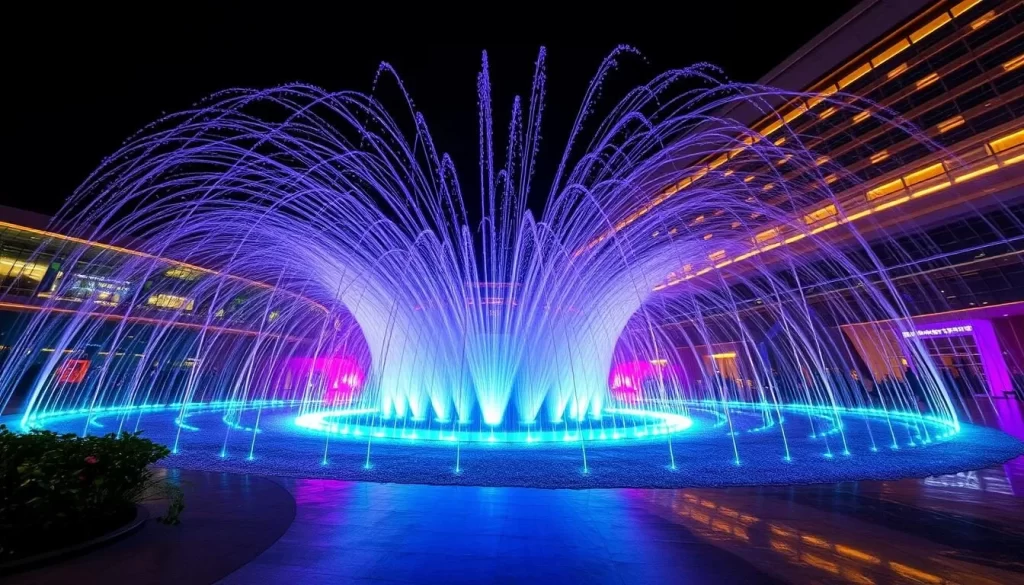
When planning your visit to Jewel Changi Airport’s Rain Vortex, timing is everything. The waterfall operates from 11 AM to 10 PM every day, and on Fridays, Saturdays, and Sundays, it starts a little earlier at 10 AM. This information is crucial in planning your day to ensure you don’t miss this breathtaking attraction.
The Rain Vortex is not just a visual marvel but also a treat for the ears, with a light and sound show that takes place every 30 minutes in the evening. The show is a spectacle that you wouldn’t want to miss, making it essential to time your visit accordingly. The evening show adds an extra layer of beauty to the already stunning waterfall.
To avoid the crowds, consider visiting during the weekdays or early in the morning. Peak tourist seasons and weekends are times when Jewel is most crowded, so planning your visit around these times can make your experience more enjoyable. If you’re looking for a more serene experience, visiting during the less busy times is advisable.
While the entrance to Jewel Changi Airport is free, some attractions within it come with a cost. For instance, accessing the Canopy Park and walking on the glass bridge costs 6 SGD per person. Understanding these costs can help you plan your visit better and budget accordingly.
Incorporating a visit to Jewel into your Singapore itinerary can be done in various ways. Whether you’re transiting through Changi Airport or making it a dedicated stop, Jewel offers a unique experience that combines nature, architecture, and entertainment. For travelers with limited time, combining a visit to Jewel with other nearby attractions can be an efficient way to make the most of your time in Singapore.
Nearby attractions that can be combined with a visit to Jewel include exploring the airport’s facilities and shopping areas or taking a short trip to other parts of Singapore. With careful planning, you can enjoy a fulfilling experience at Jewel Changi Airport and its surroundings.
Explore Singapore’s Cultural Districts
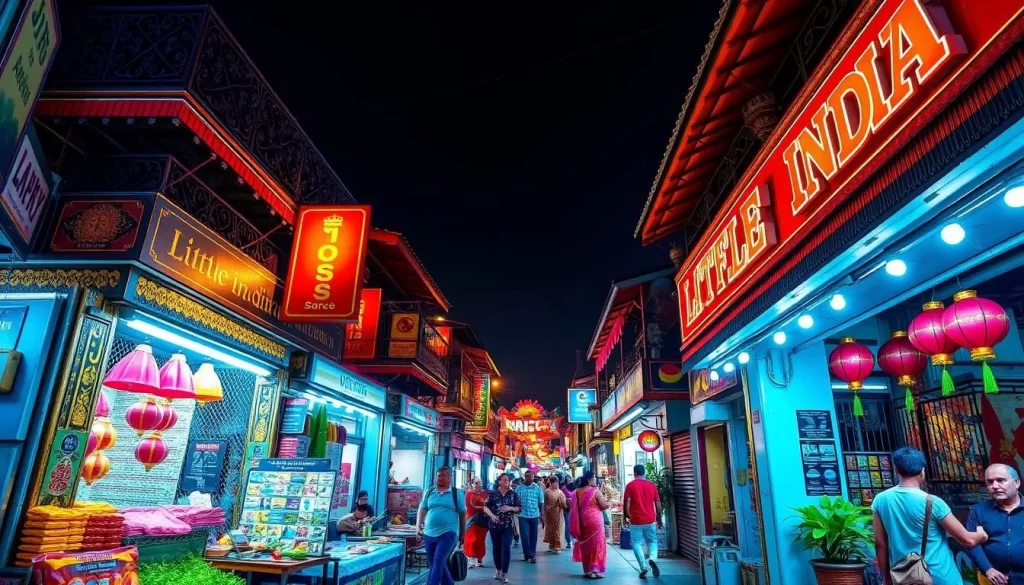
Little India is a kaleidoscope of colors, aromas, and sounds that embody the spirit of Singapore’s cultural diversity. As you step into this vibrant area, you’re immediately enveloped in the warmth and hospitality of the Indian community.
Little India: Vibrant Colors and Spices
The sensory experience of visiting Little India is unparalleled. The streets are lined with colorful flower shops, aromatic spice markets, and a plethora of Indian restaurants serving authentic cuisine. One of the highlights is the Sri Veeramakaliamman Temple, a large Hindu temple known for its elaborate displays of unique architectural style and statues of deities.
As you explore Little India, you’ll discover a treasure trove of cultural experiences. Be sure to visit the Former House of Tan Teng Niah, a beautifully restored Peranakan shophouse that now serves as a museum, showcasing the history and culture of the Peranakan community. The street art scattered throughout the area adds a modern touch to the traditional landscape.
For an authentic culinary experience, head to Mustafa Restaurant or try some of the local street food at the various food stalls. Little India comes alive during festivals like Deepavali, making it an ideal time to visit and experience the vibrant celebrations.
The significance of Little India lies in its representation of the Indian community’s contribution to Singapore’s multicultural identity. It’s a place where tradition meets modernity, creating a unique cultural melting pot that is quintessentially Singaporean.
Chinatown: Heritage and Temples
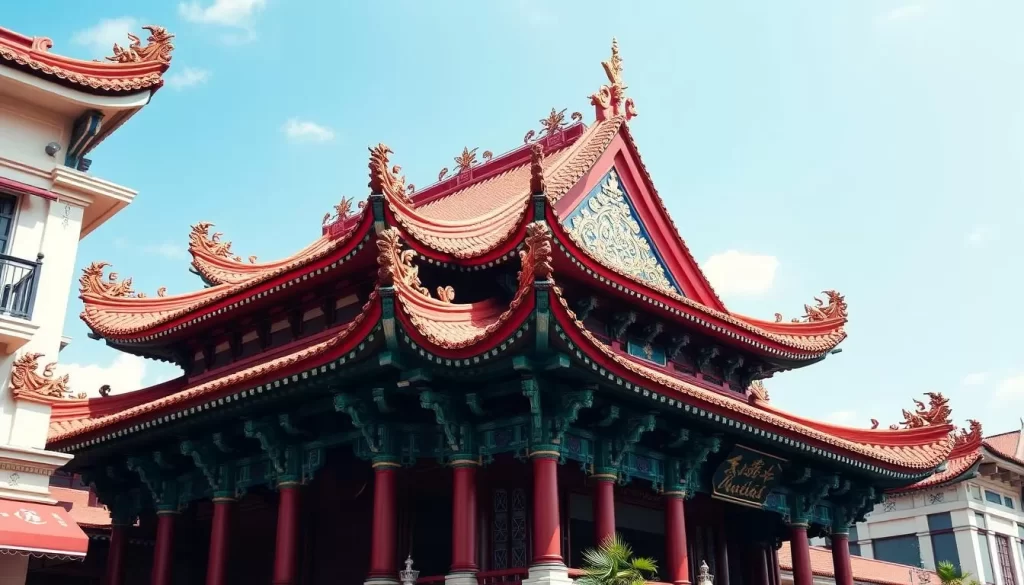
With its vibrant streets and historic temples, Chinatown is a treasure trove of Singapore’s cultural heritage. As one of the oldest cultural districts in Singapore, Chinatown has a rich history that dates back to the early days of the city.
The Buddha Tooth Relic Temple is a centerpiece attraction in Chinatown, showcasing a beautiful red and white Tang Dynasty-style architecture. This temple is not just a place of worship but also a significant cultural landmark that houses many religious relics, including the revered Buddha tooth.
As you step inside the temple, you’ll be greeted by an astonishing sight: over 10,000 Buddha images, including statues and carvings, are spread across its halls, displays, and even its roofs. The temple’s interior is a testament to the rich cultural and religious heritage of Singapore’s Chinese community.
Besides the Buddha Tooth Relic Temple, Chinatown is home to many other notable attractions, including traditional shophouses and heritage sites. Visitors can stroll through the streets and experience the district’s unique blend of traditional and modern Singapore.
Chinatown is particularly worth visiting during Chinese New Year celebrations, when the district comes alive with vibrant colors, decorations, and festivities. Even beyond this festive period, Chinatown has evolved into a vibrant district that seamlessly blends its cultural heritage with modern establishments, offering a unique experience for visitors.
Whether you’re interested in history, culture, or simply want to explore one of Singapore’s most fascinating districts, Chinatown is a place that has something for everyone.
Arab Street and Sultan Mosque
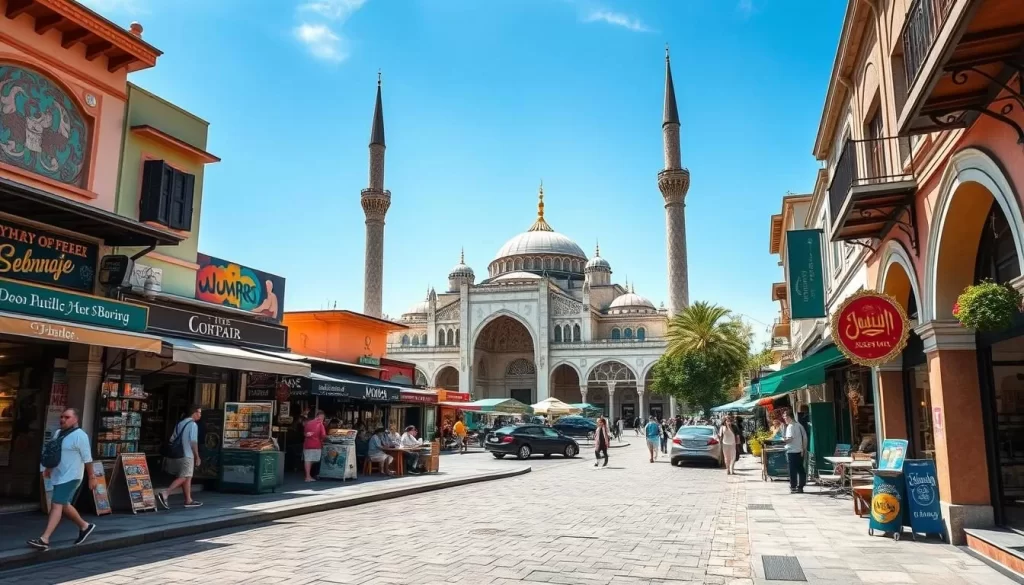
As you step into Arab Street, you’re immediately immersed in the sights and sounds of Singapore’s Muslim quarter. This historic area is known for its rich cultural heritage, with the iconic Sultan Mosque being a central landmark. The mosque, also known as Masjid Sultan, is a beautiful temple of worship with its distinctive golden domes, built by the first sultan of Singapore as a symbol of the Muslim faith.
Arab Street is not just about history; it’s also a vibrant shopping destination. The streets surrounding the mosque are lined with rows of souvenir shops, restaurants serving authentic Middle Eastern and Malay cuisine, and stores selling traditional crafts, textiles, and carpets. You can find unique souvenirs and experience the local culture firsthand.
One of the modern twists to this traditional area is the presence of impressive street art murals, adding a contemporary touch to the historic surroundings. Additionally, a visit to Haji Lane is a must; this narrow street is filled with boutique shops and hip cafes, offering a fascinating contrast to the traditional vibe of Arab Street.
The blend of old and new makes Arab Street a fascinating place to explore. You can enjoy the local cuisine at one of the many restaurants, visit the Sultan Mosque to appreciate its architectural beauty, and shop for unique souvenirs. Arab Street showcases Singapore’s Muslim heritage while evolving into a trendy district that appeals to both locals and tourists.
Stroll Around Marina Bay Waterfront
Strolling along Marina Bay Waterfront is an experience like no other, with its stunning views and iconic landmarks. As you walk, you’ll be treated to a breathtaking panorama of Marina Bay, framed by futuristic skyscrapers and impressive buildings.
Iconic Landmarks and Photo Spots
The area is dotted with iconic landmarks that make for great photo opportunities. You’ll see the distinctive Marina Bay Sands hotel, with its boat-shaped top, the flower-shaped ArtScience Museum, and the Merlion Statue, one of Singapore’s most iconic symbols.
To make the most of your visit, take a leisurely walk along the Marina Bay Waterfront Promenade, especially around sunset. The changing light and the cityscape glistening by the water as it illuminates with city lights create a truly magical ambiance.
The best times for photography are during sunset and after dark when the buildings are illuminated. You’ll capture stunning views of Marina Bay Sands and other landmarks against the night sky.
Marina Bay Sands is not just an iconic landmark; it’s also an architectural marvel. As one of the world’s most recognizable buildings, it offers a unique blend of luxury, entertainment, and innovation.
Throughout the year, Marina Bay hosts various events that attract visitors from around the world. From fireworks displays to cultural festivals, there’s always something happening in this vibrant area.
As you explore Marina Bay, take note of the historical significance of the area and how it has transformed into Singapore’s premier waterfront district. The blend of old and new, tradition and innovation, makes Marina Bay a truly unique destination.
Evening Light Shows and Ambiance
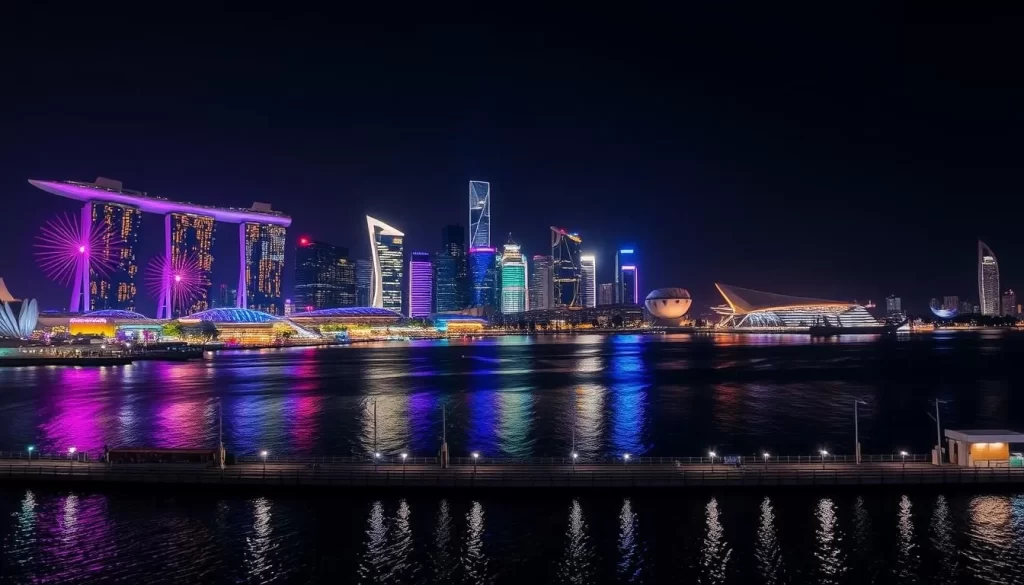
Marina Bay comes alive at night, offering a mesmerizing display of lights and water effects. The Wonder Full light and water show at Marina Bay Sands is a must-see spectacle, taking place nightly. You can catch the show at 8pm and 9pm from Sunday to Thursday, with an additional performance at 10pm on Friday and Saturday.
The entire Marina Bay area transforms after dark, with illuminated buildings creating a magical ambiance. You can enjoy the evening atmosphere at one of the many waterfront restaurants or bars, combining dinner or drinks with a leisurely stroll along the bay.
Some of the best spots to take in the views include the Marina Bay Sands SkyPark and the promenade along the waterfront. The bay area becomes a social hub in the evenings, with locals and tourists gathering to enjoy the cooler temperatures and spectacular views.
Throughout the year, Marina Bay hosts special events and seasonal light displays that enhance the regular shows. Be sure to check the calendar during your visit to catch any special happenings that might interest you.
Experience Gardens by the Bay
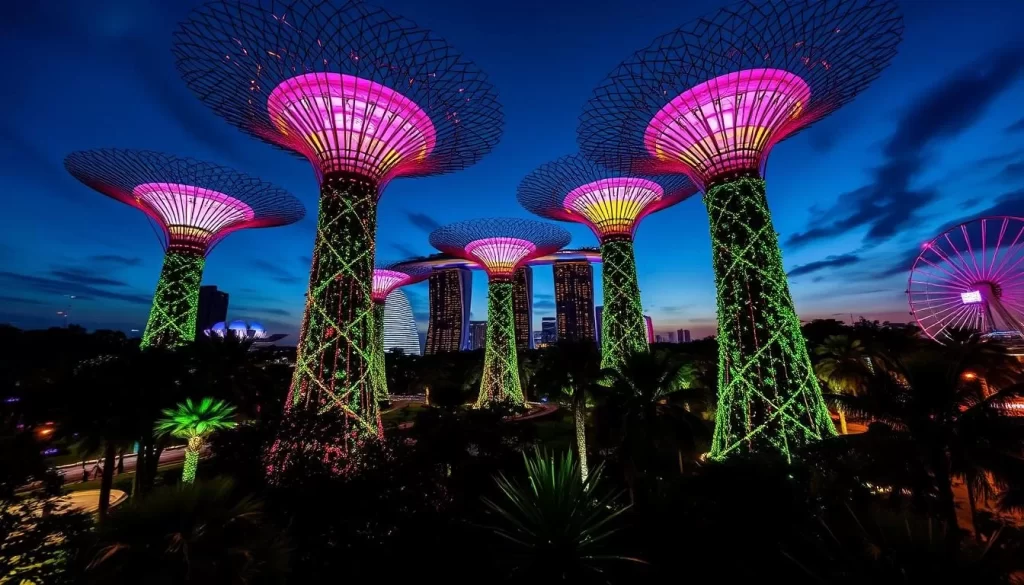
Imagine walking through a garden that’s out of this world – welcome to Gardens by the Bay, where the boundaries between nature and technology are blurred. This incredible place is a testament to Singapore’s vision of turning the city into a sustainable and green haven by 2030.
Supertree Grove and Light Shows
The Supertree Grove is one of the main attractions at Gardens by the Bay, featuring towering vertical gardens that resemble alien trees with large, striking canopies covered in colorful lights. As night falls, the Supertrees come alive with the Garden Rhapsody light and sound show, held at 7:45 PM and 8:45 PM, each show lasting about 15 minutes. This spectacle is a must-see time to visit, offering an enchanting experience.
Walking among the Supertrees is an otherworldly experience, akin to stepping onto an alien planet. The engineering behind these vertical gardens is remarkable, playing a crucial role in Singapore’s sustainable development vision. The Supertrees are not just aesthetically pleasing; they also provide shade and act as vents for the cooled air, enhancing the overall visitor experience.
To make the most of your visit, plan to arrive at the Supertree Grove around 7:30 PM to secure a good viewing spot for the Garden Rhapsody show. The OCBC Skyway, an elevated walkway, offers a different perspective as you walk among the Supertrees. After the show, you can stroll around the surrounding area, which is beautifully lit up, and explore the nearby attractions.
Gardens by the Bay is conveniently located near Marina Bay and Marina Bay Sands, making it easy to combine these attractions in your itinerary. You can enjoy the stunning views of the Marina Bay area after experiencing the futuristic gardens, creating a memorable day out in Singapore.
For the best experience, consider visiting the Supertree Grove during the late afternoon and staying for the Garden Rhapsody show. This way, you can enjoy the changing ambiance from day to night, making your visit to this iconic Gardens by the Bay even more special.
Cloud Forest and Flower Dome

Step into the futuristic glasshouses of Cloud Forest and Flower Dome, where the world’s diverse flora comes alive. At Gardens By the Bay, you’ll find these two gigantic air-conditioned glass greenhouses filled with lush green vegetation, exotic themed gardens, and a soaring waterfall, all within the glass domes.
The Cloud Forest conservatory is a marvel, featuring a 35-meter indoor waterfall and a misty mountain environment that replicates the cool, moist conditions of a tropical highland forest. This conservatory is home to a wide variety of plant species, some of which are rare and endangered.
In contrast, the Flower Dome is the world’s largest glass greenhouse, showcasing plants from Mediterranean and semi-arid regions. The Flower Dome’s unique climate-controlled environment allows it to display a vast array of flora that thrives in different conditions, making it a fascinating attraction for visitors.
Both conservatories feature art installations and exhibitions that change seasonally, making repeat visits worthwhile as you discover new displays and themes. The educational aspects of these conservatories are significant, playing a crucial role in conservation efforts by showcasing the diversity of plant life and the importance of preserving it.
To make the most of your visit, it’s recommended to arrive early or later in the day to avoid the crowds. The optimal route is to start with the Cloud Forest and then proceed to the Flower Dome, allowing you to experience the cooler climate of the Cloud Forest first.
Practical information: The greenhouses are open from 9 AM to 9 PM every day, and the entrance ticket to both places is 32 SGD per person. Consider purchasing combined passes for a more comprehensive experience of Gardens by the Bay.
Discover Fort Canning Park’s Historical Treasures
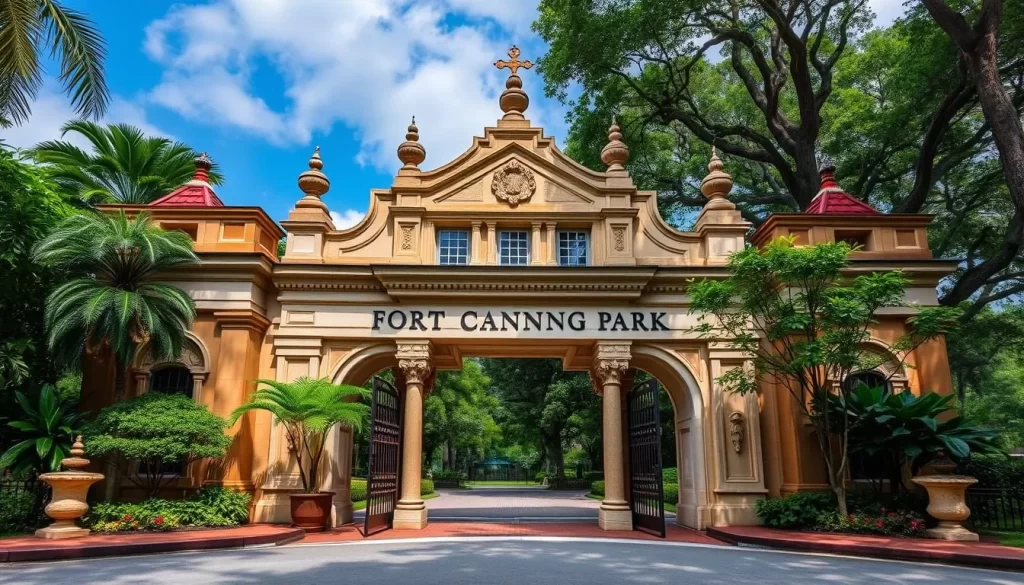
As you step into Fort Canning Park, you’re transported to a world of rich history and cultural heritage. This historical oasis in the heart of Singapore has been a silent witness to centuries of significant events.
The Battlebox and Military History
The Battlebox is an underground fortress network of bunkers and tunnels where British commanders surrendered Singapore to Japanese invaders on February 15, 1942. It’s a detailed and well-curated recollection of the fall of Singapore, which led to a three-and-a-half-year occupation. The Battlebox is a pivotal part of Singapore’s WWII history, offering a glimpse into the city’s past through its eerie, claustrophobic tunnels.
Fort Canning Park is not just a historical site; it’s an area that has witnessed the rise and fall of empires, from ancient Malay palaces to colonial military installations. The park is home to various historical landmarks, including archaeological excavation sites and colonial structures, making it a fascinating place to explore.
To get the most out of your visit, consider taking a guided tour of the Battlebox. These tours provide a comprehensive understanding of the historical significance of the park and its role in WWII. Additionally, walking through the park allows you to experience its historical layers firsthand. You can stroll through the lush greenery and visit the various landmarks, immersing yourself in the history that surrounds you.
Beyond its historical importance, Fort Canning Park also serves as a cultural venue, hosting concerts and performances in a unique historical setting. This blend of past and present makes the park a compelling destination for anyone interested in history, culture, or simply looking for a serene escape from the city’s bustle.
Tree Tunnel and Green Spaces
Amidst the urban landscape, Fort Canning Park stands out as a lush oasis, rich in history and natural beauty. As you explore this historic park, you’ll discover a variety of attractions that make it a must-visit destination.
One of the park’s most iconic features is the Instagram-famous Tree Tunnel. This picturesque spot is a photographer’s paradise, offering a unique curved tunnel shot with a massive tree stretching across the sky. To capture the perfect photo, consider visiting early in the morning when the soft light enhances the natural beauty of the surroundings.
Fort Canning Park is also home to several themed gardens, including the Spice Garden and Pancur Larangan, a small Bali-style garden. These gardens showcase the park’s botanical diversity, making it a refreshing escape from the urban environment. As you stroll through the park, you’ll encounter a variety of flora that add to its natural charm.
The park features a network of walking trails that connect different areas, offering varying levels of difficulty to suit all visitors. Whether you’re looking for a leisurely stroll or a more challenging hike, Canning Park has something for everyone. The elevation of the park also provides panoramic views of the city from various vantage points, making it an ideal spot to appreciate Singapore’s landscape.
To make the most of your visit, consider combining it with a trip to nearby attractions like the National Museum of Singapore. This will allow you to explore more of what the area has to offer. With its rich history, beautiful gardens, and scenic views, Fort Canning Park is one of the top places to visit in Singapore.
- Explore the Tree Tunnel and other themed gardens within the park.
- Enjoy the panoramic views of the city from the park’s elevated areas.
- Visit early in the morning for the best photography lighting.
- Combine your visit with nearby attractions for a fuller experience.
Savor Singapore’s Food Scene at Hawker Centers
Hawker centers are the heart of Singapore’s food culture, and a visit to Maxwell Food Centre is a must for any food enthusiast. You can experience the diverse flavors of Singapore at this renowned hawker center. Maxwell Food Centre is one of the best places to try local dishes that are both delicious and affordable.
Maxwell Food Centre: Local Favorites
Maxwell Food Centre is a culinary hotspot that has been visited by celebrities like Drew Barrymore and Dua Lipa. It’s famous for its Tian Tian Hainanese Chicken Rice, a Michelin-rated stall that serves one of the best versions of this national dish, known as chicken rice. You can enjoy a plate of succulent chicken rice from as low as $5.
Apart from Tian Tian Hainanese Chicken Rice, there are other must-try stalls at Maxwell Food Centre. For instance, Maxwell Fuzhou Oyster Cake offers a crispy, deep-fried beignet filled with oysters and prawns, available for $2.50. This diversity of food options makes Maxwell Food Centre a great place to explore different local flavors.
Hawker centers are an integral part of Singapore’s daily life, offering a vibrant atmosphere where locals and tourists alike can enjoy a wide variety of food. To navigate the hawker center experience, it’s helpful to know that you typically order food from various stalls and then sit down to enjoy your meal. Seating can be competitive, so it’s a good idea to arrive early or visit during off-peak hours to secure a spot.
The best times to visit Maxwell Food Centre are during the late morning or early afternoon to avoid the crowds. Dining at hawker centers is also remarkably affordable compared to restaurants, making it one best ways to experience Singapore’s food scene without breaking the bank, enjoying a variety of food options.
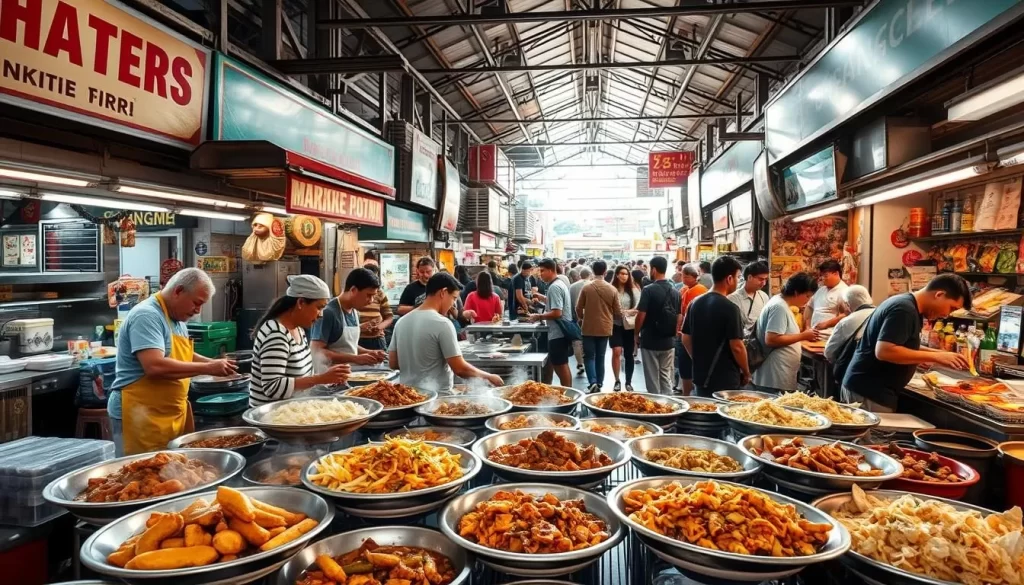
Lau Pa Sat: Historic Food Market
In the heart of Singapore’s bustling business district lies Lau Pa Sat, a historic food market that’s a must-visit, albeit slightly pricier than Maxwell.
Lau Pa Sat is not just any ordinary hawker center; it’s a culinary experience wrapped in history. The market’s distinctive Victorian architecture is a nod to its rich past, making it one of Singapore’s oldest and most revered markets. As you step inside, you’ll be greeted by the sight of numerous food stalls, each offering a unique gastronomic delight.
One of the fascinating aspects of Lau Pa Sat is its transformation throughout the day. It starts as a breakfast spot in the morning, transitions into a bustling lunch hub, and finally, transforms into a vibrant satay street in the evening. This transformation is not just about the change in clientele but also about the variety of food options available at different times.
Unlike other hawker centers that are more locally focused, Lau Pa Sat stands out for its diverse international cuisines. You can find everything from traditional Singaporean dishes to international flavors, making it a melting pot of culinary experiences. Some of the restaurants and stalls worth trying include those serving renowned satay, chili crab, and Hainanese chicken rice.
The evening is when Lau Pa Sat truly comes alive with the emergence of “Satay Street.” The adjacent street is closed to traffic, and the area is filled with satay stalls, creating a lively atmosphere that’s perfect for a night out. It’s a great way to experience the local food culture, with the added bonus of being in a lively setting.
To make the most of your visit, consider the time of day you go. For a more relaxed experience, visit during off-peak hours. If you’re looking for the full experience, including the satay street, plan your visit for the evening.
Lau Pa Sat’s central location makes it an ideal spot for tourists staying in the downtown area. Whether you’re looking for a quick meal or a leisurely dining experience, this historic food market has something to offer. With its unique blend of history, culture, and food, Lau Pa Sat is a must-visit destination in Singapore.
Must-Try Singaporean Dishes
Singapore’s culinary landscape is a melting pot of diverse flavors, reflecting the city-state’s multicultural heritage. As you explore the local food scene, you’ll discover a wide array of dishes influenced by Chinese, Malay, Indian, and Peranakan cuisines.
One of Singapore’s national dishes is Hainanese chicken rice, a simple yet flavorful dish that consists of poached chicken served with fragrant rice cooked in chicken stock, chili sauce, and ginger paste. You can find some of the one best versions of this dish at local hawker centers or restaurants like Maxwell Food Centre or Tian Tian Hainanese Chicken Rice.
The Peranakan cuisine, unique to Singapore and Malaysia, is another highlight of the local food scene. Must-try Peranakan dishes include laksa, a spicy noodle soup, and babi pongteh, a braised pork belly dish. These dishes reflect the rich cultural heritage of the Peranakan community.
For seafood lovers, chili crab is a must-try. This iconic dish consists of mud crabs cooked in a sweet and spicy tomato-based sauce. You can enjoy chili crab at various restaurants, ranging from hawker centers to high-end seafood eateries like Jumbo Seafood or Long Beach Seafood.
Starting your day with a local breakfast is also a must. Try kaya toast with soft-boiled eggs, a classic Singaporean breakfast staple. Kaya is a sweet coconut jam spread on toasted bread, often paired with a soft-boiled egg and a cup of coffee.
Singapore’s multicultural heritage is beautifully reflected in its diverse food offerings. From street food at hawker centers to fine dining experiences, there’s something for every palate. For adventurous eaters, there are also more unusual local specialties to try, such as satay or char kway teow.
One of the best ways to experience Singapore’s culinary diversity is by joining a food tour. Expert guides will take you through the city’s hidden gems, introducing you to local eateries and explaining the stories behind each dish.
Singapore, Singapore: Best Things to Do for Culture Lovers
For those intrigued by the unique cultural fusion that defines Singapore, the Peranakan Museum is an unmissable experience. This museum is dedicated to showcasing the history and heritage of the Peranakan community, a group that emerged from the intermarriage of Chinese, Malays, and Europeans in Singapore and the Straits Settlements.
Peranakan Museum and Heritage
The Peranakan Museum is housed in a former Chinese school in the Civic District and boasts three stories of exhibits. The museum’s collection includes intricately beaded shoes, ornate ceramic ware, and beautiful Catholic altars, reflecting the strong European influence on Peranakan culture. One of the museum’s most fascinating artifacts is a rare wooden baby carriage reminiscent of horse-drawn carriages, highlighting the blend of different cultural traditions.
To understand the significance of the Peranakan Museum, it’s essential to know who the Peranakans are. The Peranakans are a unique cultural group that developed in Singapore and other parts of the Straits Settlements. They are known for their vibrant culture, which is a blend of Chinese, Malay, and European influences. The Peranakans played a significant role in Singapore’s history, contributing to the country’s cultural, economic, and social development.
The museum’s exhibits provide a window into the unique hybrid culture that developed in Singapore. You can see intricate beadwork, porcelain, and furniture that characterize Peranakan material culture. The museum also offers insight into the daily lives of the Peranakans, their customs, and their traditions.
| Exhibit | Description |
|---|---|
| Intricately Beaded Shoes | Showcasing the intricate beadwork that Peranakan women were known for |
| Ornate Ceramic Ware | Highlighting the European influence on Peranakan ceramics |
| Beautiful Catholic Altars | Reflecting the religious practices and influences on Peranakan culture |
Visiting the Peranakan Museum is not just about seeing artifacts; it’s an immersive experience into Singapore’s cultural heritage. You can combine your visit with an exploration of Peranakan heritage in neighborhoods like Joo Chiat, known for its colorful Peranakan houses. Additionally, there are other cultural institutions nearby that complement the Peranakan Museum experience, such as the National Gallery Singapore, which is dedicated to Southeast Asian art.
The Peranakan Museum provides context for many aspects of Singapore’s contemporary culture. It also hosts special exhibitions and programs that enhance the permanent collection, offering visitors a fresh perspective on Peranakan culture each time they visit. Entry to the museum costs $18, a worthwhile investment for anyone interested in Singapore’s rich cultural tapestry.
By exploring the Peranakan Museum and its surroundings, you’ll gain a deeper understanding of the cultural heritage that makes Singapore so unique. Whether you’re an art enthusiast, a history buff, or simply someone who appreciates cultural diversity, the Peranakan Museum is a must-visit destination in Singapore.
National Gallery Singapore
As you explore the Civic District, you’ll discover the National Gallery Singapore, home to over 8,000 pieces of Southeast Asian art. The gallery is housed in the neoclassical, colonial-era former Supreme Court and City Hall buildings, making it a masterpiece of repurposed architecture. With a collection that spans the 19th century through to the modern day, the National Gallery Singapore is a treasure trove of artistic heritage.
The National Gallery Singapore is recognized as the world’s largest public collection of Singapore and Southeast Asian art. Prominent artists include the Vietnamese lacquer painter Nguyen Gia Tri and the Singaporean painter Georgette Chen. The gallery provides a unique insight into Singapore’s artistic heritage and its place within the broader Southeast Asian cultural landscape. You can explore the gallery’s extensive collections, which include a wide range of artworks from different periods and styles.
Some of the key things to do at the National Gallery Singapore include:
- Exploring the gallery’s permanent collections, which showcase the best of Southeast Asian art.
- Visiting the rooftop spaces and restaurants, which offer unique views of the Civic District.
- Taking part in guided tours or using multimedia guides to enhance your understanding and appreciation of the artworks.
- Attending special exhibitions and programs that complement the permanent collection.
The National Gallery Singapore has become a cultural hub, hosting various events beyond traditional art exhibitions. It’s a place where you can experience the rich cultural heritage of Southeast Asia, with a diverse range of activities and exhibitions. Whether you’re an art enthusiast or just looking for something new to do, the National Gallery Singapore is definitely worth a visit.
By visiting the National Gallery Singapore, you’ll gain a deeper understanding of Southeast Asian art and its significance. With its stunning architecture, extensive collections, and engaging programs, the gallery offers a unique and enriching experience for visitors.
Explore Hidden Gems in Joo Chiat District
Tucked away in Singapore is the charming Joo Chiat District, a treasure trove of vibrant Peranakan culture and heritage. This upcoming heritage district is home to some of the most beautiful and historical Peranakan buildings, as well as unique and diverse eateries.
The Joo Chiat area is one of Singapore’s most photogenic neighborhoods, boasting rows of colorful Peranakan shophouses that are a delight to explore. As you wander through this vibrant area, you’ll discover the rich history and cultural significance of the Peranakan community.
A Kaleidoscope of Colors
The shophouses in Joo Chiat are a testament to the Sino-Portuguese architectural style, adorned with Asian hybrid elements like colorful paintings and symbols of Chinese origin. These distinctive architectural features make the area a fascinating place to explore, with places like Koon Seng Road offering a glimpse into the past.
As you stroll through Joo Chiat, you’ll be treated to a visual feast of colors and patterns. The area is not just a treat for the eyes but also a cultural experience, preserving the heritage of the Peranakan community. For any Singapore tourist looking to experience the authentic culture of Singapore, Joo Chiat is a must-visit destination.
To make the most of your visit, consider taking a walking route that covers the most picturesque streets and buildings. The best times for photography are during the golden hour, when the soft light enhances the vibrant colors of the houses.
Joo Chiat District provides a unique glimpse into Singapore’s pre-skyscraper past and traditional neighborhood life, making it a fascinating area to explore. With its blend of history, culture, and vibrant colors, it’s an experience you won’t soon forget.
Local Eateries and Cafes
Joo Chiat is a food lover’s paradise, offering everything from traditional Peranakan cuisine to modern cafe culture. As you explore this vibrant district, you’ll discover a diverse array of eateries that cater to all tastes and preferences.
The district is home to renowned eateries like 328 Katong Laksa, a local favorite that even Gordon Ramsay visited for one of his cooking shows. This eatery’s success story is a testament to the district’s culinary excellence. You can also visit Petit Pain, a lovely little bakery that serves some of the crispiest croissants in town.
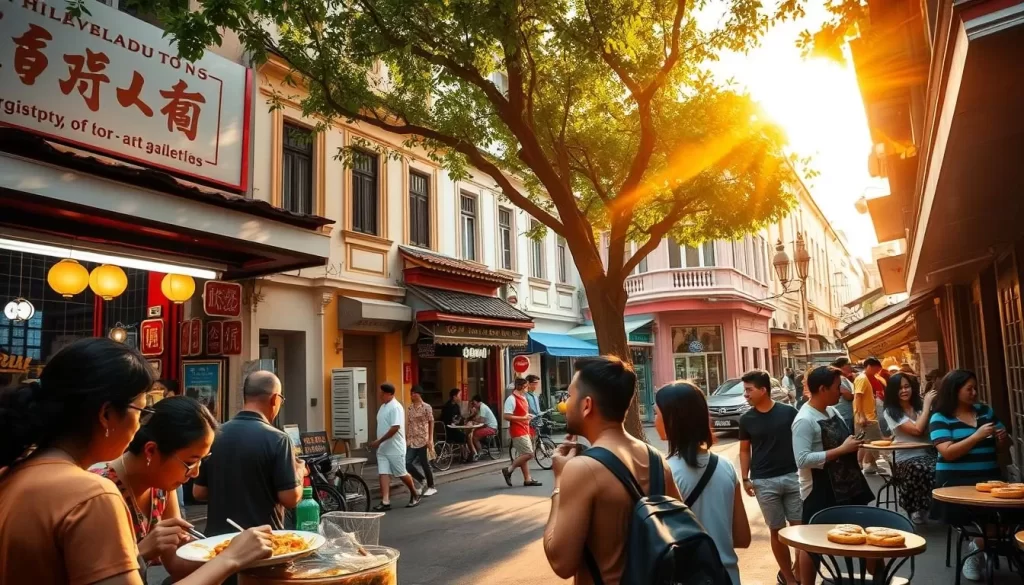
The food scene in Joo Chiat reflects the area’s multicultural heritage and Singapore’s position in Southeast Asia. You can sample traditional Peranakan dishes, enjoy local delicacies like Laksa, or savor international cuisine at one of the many modern cafes. Specialty food shops selling traditional Peranakan kueh (cakes) and other local treats are also worth visiting.
For a unique dining experience, consider a food crawl itinerary that allows you to sample multiple establishments in one visit. Some recommended stops include:
- Traditional Peranakan restaurants serving authentic dishes
- Modern cafes offering a range of international cuisine
- Specialty food shops selling traditional Peranakan kueh and other local delicacies
- Lesser-known local favorites that are off the beaten path
The cafe culture in Joo Chiat has transformed parts of the district, bringing a modern twist to its heritage. Visitors can enjoy a coffee or meal at one of the many trendy cafes, each with its unique ambiance and charm.
| Eatery | Cuisine | Notable Feature |
|---|---|---|
| 328 Katong Laksa | Peranakan | Gordon Ramsay visited for a cooking competition |
| Petit Pain | Bakery | Crispiest croissants in town |
| Local Cafe | International | Trendy ambiance |
Whether you’re a food enthusiast or just looking to try something new, Joo Chiat’s diverse dining scene has something for everyone. As a Singapore tourist, exploring the local eateries and cafes is a great way to experience the city’s culinary culture, which is deeply rooted in its Southeast Asia heritage.
Enjoy Panoramic Views of Singapore
If you’re looking for a panoramic view of Singapore, Sky Garden is the place to be. Located on the 51st floor of CapitaSpring Tower, this observation deck offers an incredible 360° view of the city.
A Unique Green Space Concept
Sky Garden is not just any ordinary observation deck; it’s a beautiful balcony area attached to a bar, providing a lush garden setting amidst the skyscrapers. The unique green space concept combines an observation deck with a garden, making it a must-visit attraction in Singapore.
When planning your visit, it’s essential to understand the booking process. You can book a time slot, including free time slots and bar admission tickets, to make the most of your experience. The best time to visit is during sunset and early evening when the city lights start to twinkle.
For photography enthusiasts, Sky Garden offers a plethora of opportunities to capture the cityscape from a unique vantage point. To make the most of your photography session, consider visiting during the golden hour or when the city is lit up at night.
Compared to other viewpoints in the city, Sky Garden stands out due to its unique blend of a garden and an observation deck. The dining and drinking options available at the venue enhance the overall experience, making it a great place to relax and enjoy the views.
| Time of Visit | Best For | Tips |
|---|---|---|
| Sunset | Golden hour photography | Bring a camera with a good battery life |
| Early Evening | City lights and ambiance | Arrive early to secure a good spot |
| Night | Nightlife and cityscape | Enjoy the bar’s offerings while taking in the views |
Whether you’re a local or a tourist, Sky Garden at CapitaSpring Tower is a great place to experience the best of Singapore’s cityscape. With its unique concept, stunning views, and great dining options, it’s a must-visit attraction that should be on your list of things to do in Singapore.
Marina Bay Sands SkyPark
For a panoramic view of Singapore that will leave you speechless, head to the Marina Bay Sands SkyPark. As one of the most recognizable landmarks in Singapore’s skyline, Marina Bay Sands has been featured in numerous films, making it a must-visit attraction.
The SkyPark Observation Deck, located on the 57th floor, offers 360-degree panoramic views of the city. To the north, you can see the historic district with its colonial-era buildings. Looking east, the Marina Bay area unfolds with its futuristic architecture. To the south, the sea and the southern islands are visible on a clear day. Westward, you’ll see the city-state’s vibrant heart, with towering skyscrapers dotting the landscape.
The architectural significance of the SkyPark cannot be overstated. It is a feat of engineering, cantilevered 67 meters beyond the last tower, providing an unparalleled viewing experience. The famous infinity pool, accessible to hotel guests only, has become a symbol of luxury in Singapore.
For optimal views and photography opportunities, visit the SkyPark during the late afternoon or early evening to catch the sunset. It’s advisable to combine your visit to the observation deck with other attractions within the Marina Bay Sands complex to make the most of your time.
| Ticket Information | Opening Hours | Tips |
|---|---|---|
| Entry costs $35 | Opens from 9:30 AM to 10:00 PM | Visit during off-peak hours to avoid queues |
| Discounts available online | Last entry at 9:30 PM | Combine with other Marina Bay Sands attractions |
Visiting the Marina Bay Sands SkyPark is an experience that encapsulates the essence of Singapore’s blend of innovation, luxury, and breathtaking views. It’s a fitting end to any Singapore trip, leaving you with unforgettable memories.
Experience Singapore’s Nightlife
Singapore’s nightlife is a sophisticated blend of style, creativity, and fun, offering something for every kind of traveler. As you explore the city, you’ll discover a range of bars and lounges that showcase the best of Singapore’s hospitality and mixology.
Sophisticated Cocktail Culture
Singapore has several venues frequently touted as among Asia’s best bars. The casual and intimate Jigger & Pony, with its menus designed to look like magazines, ranked third on the list. One of the most impressive is Night Hawk, a speakeasy with a design inspired by the iconic Edward Hopper painting “Nighthawks.”
Hidden behind a nondescript red door, it has a banging soundtrack, with an analog flipboard displaying the name of every song currently playing. You can experience the best of Singapore’s nightlife by visiting some of its world-class speakeasy bars. These hidden gems are often tucked away in unassuming locations, requiring you to know where to look.
The speakeasy concept is all about exclusivity and secrecy, adding to the allure and excitement of discovering these hidden venues. The creative cocktail programs at these bars often incorporate local ingredients and flavors, giving you a unique taste of Singapore.
If you’re planning to bar-hop, consider starting your evening in the early hours to avoid crowds and secure seating at popular venues. Dress codes and etiquette are also important to keep in mind, as many of Singapore’s upscale cocktail establishments have a smart casual or formal dress code.
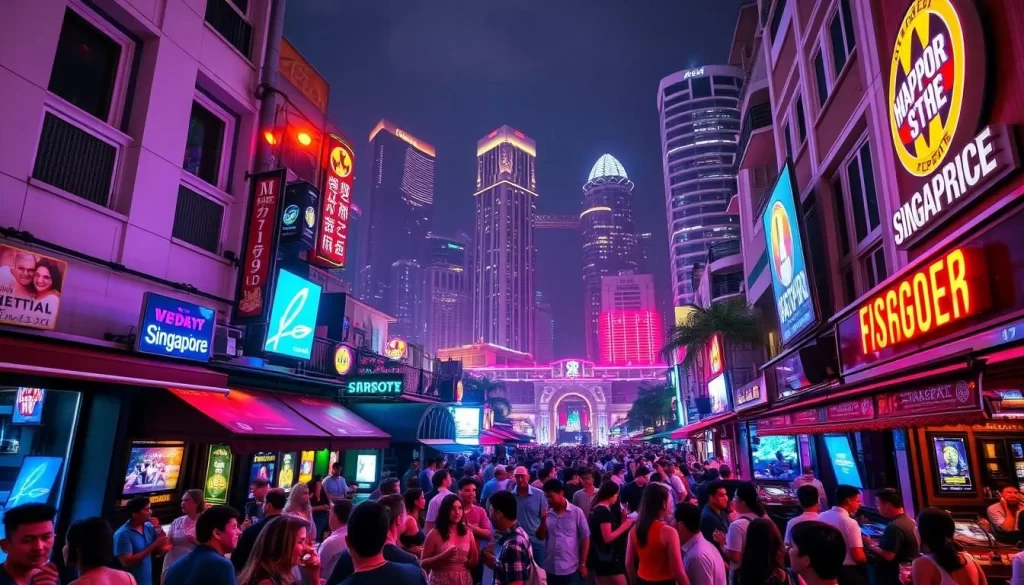
An evening bar-hopping itinerary could take you through different neighborhoods, such as Clarke Quay, Robertson Quay, or Marina Bay, each offering a distinct vibe and selection of bars. You can start at a rooftop bar with a stunning view, followed by a visit to a speakeasy or a trendy cocktail lounge.
By experiencing Singapore’s nightlife, you’ll get to see a different side of the city and its people. Whether you’re looking for a relaxed evening or an energetic night out, Singapore’s bars and lounges have something to offer at any time.
Rooftop Bars with Skyline Views
Singapore’s rooftop bars offer a unique perspective on the city, especially during sunset. As you sip on a crafted cocktail, you can enjoy the spectacular views of the skyline. The Cooling Tower, located on the 29th floor of Carlton City Hotel, is a great place to start. It offers great views of the Singapore harbor coastline.
If you’re looking for a more intimate setting, Enclave Bar is a smaller, cozier venue that serves Thai-inspired cocktails. The atmosphere is relaxed, making it an ideal spot to unwind while taking in the city views. Cocktails at these bars start from around $22, offering a range of options to suit different tastes.
The best time to visit these rooftop bars is during sunset or at night when the city is illuminated. Marina Bay Sands and the surrounding area transform into a dazzling spectacle, making it a great time to enjoy the views. You can experience the city’s vibrant atmosphere while savoring a signature cocktail.
Some rooftop bars host seasonal events and parties throughout the year, adding to the excitement. Whether you’re looking for a sophisticated lounge or a casual spot, Singapore’s rooftop bars have something to offer. You can enjoy the panoramic views of the city, making for a memorable experience.
When planning your visit, consider the time of day and the atmosphere you prefer. Whether it’s the golden hour or the nighttime panorama, Singapore’s rooftop bars are sure to leave a lasting impression.
Take a Day Trip to Pulau Ubin
Pulau Ubin is a hidden gem waiting to be explored on a day trip from Singapore, offering a glimpse into the country’s history and natural beauty. This small, lush green island, located in the northeastern part of Singapore, is a stark contrast to the modern city, serving as a time capsule of Singapore’s rural past.
To get to Pulau Ubin, you take a bumboat from Changi Point Ferry Terminal. The short journey sets the tone for a day of adventure and exploration. Upon arrival, you’ll be greeted by the island’s serene atmosphere, which is a welcome respite from the hustle and bustle of city life.
Cycling Through Nature
One of the best ways to explore Pulau Ubin is by bicycle. You can rent bicycles on the island, and with bike lanes and hiking trails available, you’re all set for an exciting day. The trails range from easy paths suitable for families to more challenging routes for the adventurous.
The island is home to several key attractions, including the Chek Jawa Wetlands, a haven for nature lovers, and abandoned quarries, which provide a glimpse into the island’s industrial past. You can plan your day to include stops at these places, as well as time to rest and refresh at one of the local eateries.
As you cycle through the island, keep an eye out for the diverse wildlife that Pulau Ubin is home to, including wild boars, monitor lizards, and a variety of bird species. This day trip not only offers a fun day out but also provides valuable insight into Singapore’s pre-development days and the country’s conservation efforts.
For a fulfilling day trip, consider an itinerary that includes a mix of cycling, exploration, and relaxation. Pulau Ubin offers a unique blend of things to do, from adventure to relaxation, making it an ideal day trip destination for those looking to experience the natural and historical side of Singapore.
How to Get There and What to Expect
Getting to Pulau Ubin is a straightforward process that involves a short ferry ride from Changi Point Ferry Terminal, making it an ideal day trip destination in Southeast Asia.
To get to Changi Point Ferry Terminal, you can take a taxi or drive from various parts of Singapore. If you’re using public transport, take the MRT to Tanah Merah Station, then board Bus 2 or 29 to Changi Village. From there, it’s a short walk to the ferry terminal.
The ferry system, known as a bumboat, is an exciting part of the experience. These boats typically depart when they have enough passengers, so it’s a good idea to arrive early to avoid waiting too long. The journey takes around 15 minutes and costs approximately 4 SGD one way.
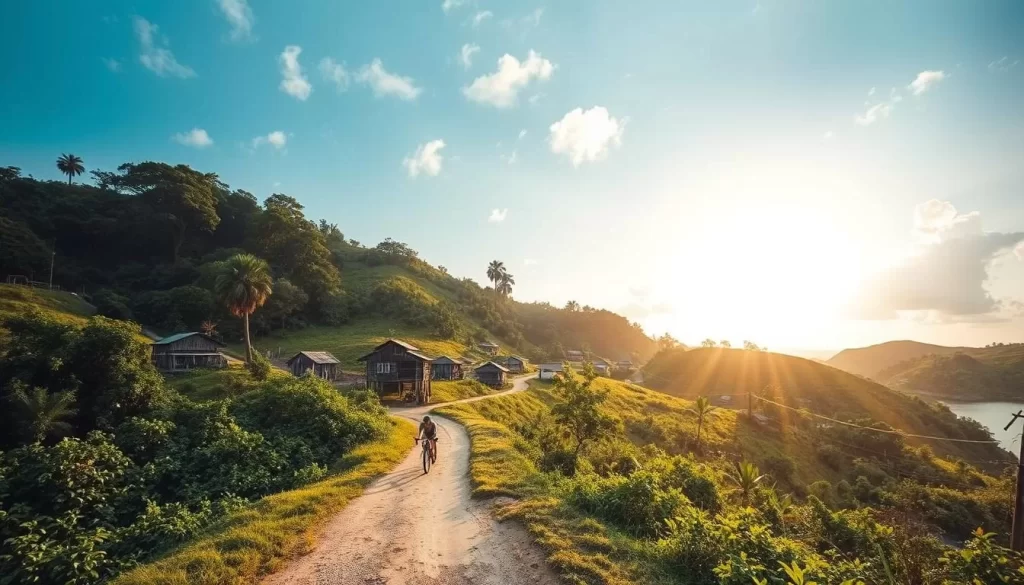
Once you arrive on the island, you can rent a mountain bike for the day at one of the many rental shops. The cost is around 10-15 SGD for the entire day. It’s essential to bring necessary items like water, sunscreen, and insect repellent, as the facilities on the island are limited.
- Water and snacks to keep you hydrated and energized throughout the day
- Sunscreen and a hat to protect yourself from the sun
- Insect repellent to keep bugs at bay
- A basic first-aid kit
- Cash, as ATMs are limited on the island
Pulau Ubin is a significant cultural landmark in Southeast Asia and country of Singapore, offering a glimpse into the past. It’s one of the last remaining rural areas in Singapore, providing a unique experience that differs from other nature reserves in the country.
To avoid crowds, consider visiting on weekdays instead of weekends. The island’s rustic charm and historical significance make it a must-visit destination for anyone looking to explore beyond the urban landscape of Singapore.
Conclusion: Making the Most of Your Singapore Visit
Your visit to Singapore is not just a trip; it’s an exploration of a vibrant city that balances urban development with natural beauty. As you reflect on your journey, you’ll find that Singapore’s unique blend of modernity and tradition makes it a standout destination in the world.
Singapore is a country that offers a diverse array of attractions and experiences, from the futuristic Gardens by the Bay to the historic streets of Chinatown. With almost 50% of the city covered in green spaces, you can enjoy a variety of things to do, including visiting the Supertree Grove, exploring the Cloud Forest, and taking a leisurely stroll along the Marina Bay Waterfront.
To make the most of your visit, consider the ideal trip duration based on your interests. For culture enthusiasts, a guide to the city’s cultural districts, such as Little India and Arab Street, can be invaluable. For nature lovers, a day trip to Pulau Ubin is a must. Singapore’s year-round tropical climate means you can visit at any time, but be sure to plan accordingly and stay hydrated.
One of the advantages of visiting Singapore is its safety, cleanliness, and efficiency, making it an ideal destination for first-time visitors to Asia. The city hosts various seasonal events and festivals, such as the Singapore Grand Prix and the Singapore International Film Festival, which can enhance your travel experience.
As you explore beyond the typical tourist attractions, you’ll discover the authentic Singapore, with its vibrant street food scene at hawker centers like Maxwell Food Centre and Lau Pa Sat. With its unique twist on street food, Singapore offers a culinary experience that’s both affordable and delicious.
In conclusion, Singapore continues to evolve while preserving its multicultural heritage, making it a fascinating city to visit. With so many things to see and do, you’re sure to have a memorable trip. As you plan your visit, consider exploring the lesser-known areas, such as Joo Chiat District, to experience the real essence of this incredible country. Whether you’re interested in history, culture, or entertainment, Singapore has something for everyone, making it a top destination for travelers from around the world.
The above is subject to change.
Check back often to TRAVEL.COM for the latest travel tips and deals.

